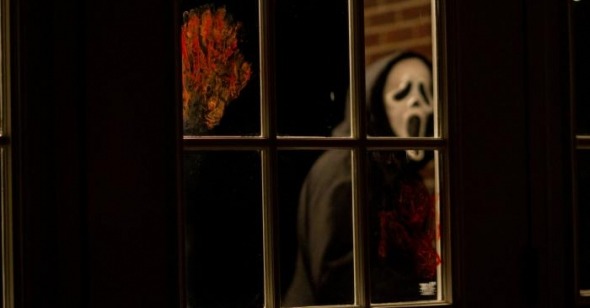Monday Hangover
Scream 4
By Adam Nayman and Justin Stewart
Late in Scream 4, a character desperately recites a long list of horror movie titles. It’s an act of name-dropping that’s also a last, desperate stab at self-preservation, because, if she eventually cites the right one, she’ll be spared from death at the hands of whoever it is that has donned the series’ trademark black cloak and mass-produced Munchian mask. Or so she thinks, anyway: her incantatory inventory of late-twentieth-century genre filmmaking succeeds only in marking time before a well-placed knife to the gut removes her from the narrative—and by extension our suspicion that she’s the one behind the series’ iconic Ghostface Killer costume, a shell game which remains the only real point of narrative interest. (SPOILER ALERT: the killer is the One You Least Suspect). In a movie that is nothing if not aware of its own operations, this is something like an unguarded moment or even a despairing autocritique, although this is surely not the intention. Putting his most hallowed titles in the mouths of a babe, Kevin Williamson means to assert his genre savvy, yet the evidence of a stacked DVD shelf proves to be a fruitless defense mechanism for writer and character both.
I guess it’s interesting to note that the biggest difference between this perfectly well made and completely superfluous third sequel and its now-fifteen-year-old source material is the degree to which the principal characters are film-literate. In Scream, only Jamie Kennedy’s Randy was familiar enough with the history and embedded “rules” of scary movies (basically, a Cliffs Notes version of Carol Clover’s landmark 1992 study Men, Women and Chainsaws: Gender in the Modern Horror Film) to try to profit—or at least survive—by them; now it’s assumed that people on both sides of the screen have an informed appreciation for various stalk-n-slash formulas.
That’s fair enough, since in the world of the film the characters have been inundated with a cycle of Stab movies—cash-ins on the ongoing saga of Sidney Prescott (Neve Campbell), who attracts serial killers like moths to a flame—just as we’ve had to endure sequels as well as imitations, rip-offs, and parodies of a movie that was already a winking synthesis of a half-dozen late-night cable staples. So it’s neither surprising, nor really objectionable, that Scream 4 is so self-reflexive. The problem is that it isn’t scary. Its ersatz opening movements, set inside the diegesis of the Stab series, are precisely as unsettling as the actual curtain raiser they eventually segue into after ten minutes of ostensible meta-hilarity—which is to say: not very. For whatever reason (and I can think of a few), Wes Craven's heart, never his strongest organ as a filmmaker, doesn't seem to be in this one. The kill scenes lack for variety, innovation, and the precisely wrought shocks that made the first Scream and at least the first half of Scream 2 playful and startling in roughly equal measures. That sense of ruthlessness is gone, and without it, even the authentically R-rated gore feels dully obligatory rather than bracingly old-school. —AN
Obligatory and despairing are the key words, I think. This entry (which, according to reports, was intended as the start of a second trilogy—its weekend returns might make that unlikely), as with the first three Screams, actualizes Truffaut’s “film lovers are sick people” thing; it’s a study in joylessness. The stabby kills seem to get louder as the movie wears on (I found myself wondering what the Foley artist was really goring), while Craven's boredom grows more palpable.
He shouldn’t be bored, because the concept (calling attention to the genre at hand) he struck upon in Scream run-up New Nightmare remains novel. The parodies you alluded to, Adam, are evidence that he and writer Kevin Williamson still haven’t gone far enough. Irony this total should be unpuncturable. Calling it self-aware might be giving it more credit than it’s worth. The Scream films are only insecurely obnoxious about it, and they never seem to do as much with the meta concept as they could. When a couple of characters watch Shaun of the Dead here, I don’t think even Craven knows what he’s being ironic about.
Drew Barrymore’s wireless phone has been replaced by a cell, and Williamson’s general idea of updating the material consists of Facebook and Saw mentions. The new Jamie Kennedy character walks around with a camera on his head, though Craven wastes the gimmick’s potential. Otherwise, Scre4m is firmly, almost touchingly, crusty. Its particular vintage of teenage cinephilia feels old-fashioned in the way only a 46-year-old screenwriter could achieve. I like that the Woodsboro High School has a cinema club (they host a Stab-athon in a barn), but I’m not sure if it’s a joke that they have a Green Mile poster on their meeting room wall. (More poster laffs: like the girl in Taken, one of the Scream teens has a U2 poster in her bedroom—the prop department must have a surplus).
The name-dropping scene that you mention might be Williamson’s sad autobiographical cri de coeur. The Scream movies (though he didn’t write the awful third one) are nothing if not examples of him hunched over a keyboard, sweatily listing references. They’re annoyingly “smart,” and the charge one gets from hearing Peeping Tom referenced (the true first slasher film, according to this round’s Ghostface) is nothing but a dull buzz. —JS
